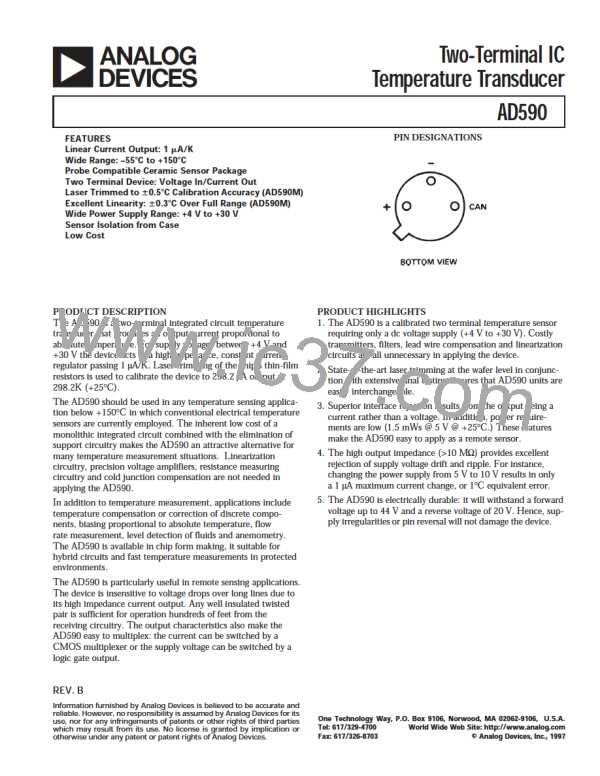AD590
Figure 14. 4 m A-to-20 m A Current Transm itter
Figure 14 is an example of a current transmitter designed to be
used with 40 V, 1 kΩ systems; it uses its full current range of
4 mA-to-20 mA for a narrow span of measured temperatures. In
this example the 1 µA/K output of the AD590 is amplified to
1 mA/°C and offset so that 4 mA is equivalent to 17°C and
20 mA is equivalent to 33°C. RT is trimmed for proper reading
at an intermediate reference temperature. With a suitable choice
of resistors, any temperature range within the operating limits of
the AD590 may be chosen.
Figure 16. DAC Set Point
low) in 0.2°C steps. T he comparator is shown with 1°C
hysteresis which is usually necessary to guard-band for extrane-
ous noise; omitting the 5.1 MΩ resistor results in no hysteresis.
Figure 15. Sim ple Tem perature Control Circuit
Figure 15 is an example of a variable temperature control circuit
(thermostat) using the AD590. RH and RL are selected to set the
high and low limits for RSET. RSET could be a simple pot, a
calibrated multiturn pot or a switched resistive divider. Power-
ing the AD590 from the 10 V reference isolates the AD590 from
supply variations while maintaining a reasonable voltage (~7 V)
across it. Capacitor C1 is often needed to filter extraneous noise
from remote sensors. RB is determined by the β of the power
transistor and the current requirements of the load.
Figure 17. AD590 Driven from CMOS Logic
T he voltage compliance and the reverse blocking characteristic
of the AD590 allows it to be powered directly from +5 V
CMOS logic. T his permits easy multiplexing, switching or
pulsing for minimum internal heat dissipation. In Figure 17 any
AD590 connected to a logic high will pass a signal current
through the current measuring circuitry while those connected
to a logic zero will pass insignificant current. T he outputs used
to drive the AD590s may be employed for other purposes, but
the additional capacitance due to the AD590 should be taken
into account.
Figure 16 shows the AD590 can be configured with an 8-bit
DAC to produce a digitally controlled set point. T his particular
circuit operates from 0°C (all inputs high) to +51°C (all inputs
REV. B
–8–

 ADI [ ADI ]
ADI [ ADI ]